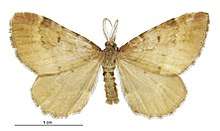Asaphodes imperfecta
Asaphodes imperfecta is a moth in the family Geometridae. It is endemic to New Zealand. It is classified as critically endangered by the Department of Conservation.
| Asaphodes imperfecta | |
|---|---|
 | |
| Male | |
| Scientific classification | |
| Kingdom: | Animalia |
| Phylum: | Arthropoda |
| Class: | Insecta |
| Order: | Lepidoptera |
| Family: | Geometridae |
| Genus: | Asaphodes |
| Species: | A. imperfecta |
| Binomial name | |
| Asaphodes imperfecta | |
| Synonyms | |
| |
Taxonomy
This species was first described by Alfred Philpott in 1905 as Xanthorhoe imperfecta.[3][4] Philpott used specimens he collected in the West Plains suburb of Invercargill.[4] In 1971 John S. Dugdale assigned Xanthorhoe imperfecta to the genus Asaphodes.[5]
Description
Philpott described A. imperfecta as follows:
29 mm. Head, thorax, and abdomen brownish-ochreous. Fore wings ochreous, in male often reddish on costa and about apex. The usual lines are in the male reduced to irregular blackish costal spots ; in the female these costal spots give rise to very faint transverse waved lines. White spots follow most of the dark costal spots, and there is a fairly conspicuous pair at 2⁄3 ; cilia ochreous, barred with blackish. Hind wings ochreous ; cilia greyish-ochreous mixed with darker. Nearest to X. ceyrota, but easily distinguished by the brighter ground-colour and the white costal spots.[4]
Distribution
Asaphodes imperfecta is endemic to New Zealand.[2][6] The species was regarded as being rare and local to the southern part of the South Island.[7] It is now regarded as being locally extinct in its type locality of Invercargill.[8] George Vernon Hudson mentions that it was also present in Dunedin.[7]
Ecology and habitat
Adult moths had been collected in forest[8] and Hudson stated the species preferred low lying swampy forest habitat.[7] Hudson also stated that adult moths were on the wing in December and January.[7]
Host plants
The host plants of this species are unknown.[9]
Conservation status
This moth is classified under the New Zealand Threat Classification system as being Nationally Critical.[1] It has been hypothesised that this species is under threat as a likely result of habitat loss, given the drying out of ecosystems as a result of wetland drainage which in turn ensures the land no longer supports the plants the species lives on in its larvae stage.[10]
References
| Wikimedia Commons has media related to Asaphodes imperfecta. |
| Wikispecies has information related to Asaphodes imperfecta |
- Hoare, R.J.B.; Dugdale, J.S.; Edwards, E.D.; Gibbs, G.W.; Patrick, B.H.; Hitchmough, R.A.; Rolfe, J.R. (2017). Conservation status of New Zealand butterflies and moths (Lepidoptera), 2015 (PDF). Wellington, New Zealand: New Zealand Department of Conservation. p. 5. ISBN 9781988514383.
- "Asaphodes imperfecta (Philpott, 1905)". www.nzor.org.nz. Landcare Research New Zealand Ltd. Retrieved 30 April 2018.
- Dugdale, J. S. (1988). "Lepidoptera - annotated catalogue, and keys to family-group taxa" (PDF). Fauna of New Zealand. 14: 173. Retrieved 30 April 2018.
- Philpott, Alfred (1905). "On some new species of Lepidoptera". Transactions and Proceedings of the New Zealand Institute. 37: 328–333 – via Biodiversity Heritage Library.
- Dugdale, J. S. (10 November 1971). "Entomology of the Aucklands and other Islands south of New Zealand: Lepidoptera, excluding non-Crambine Pyralidae" (PDF). Pacific Insects Monograph. 27: 55–172 – via Bishop Museum.
- Gordon, Dennis P., ed. (2010). New Zealand inventory of biodiversity. Volume two. Kingdom animalia : chaetognatha, ecdysozoa, ichnofossils. Vol. 2. Christchurch, N.Z.: Canterbury University Press. p. 459. ISBN 9781877257933. OCLC 973607714.
- Hudson, G. V. (1928). The Butterflies and Moths of New Zealand. Wellington: Ferguson & Osborn Ltd. p. 121.
- Patrick, Brian H. (2017). "Ecology and conservation of the rare moth Asaphodes frivola Meyrick". The Weta. 47: 17–38. Retrieved 30 April 2018.
- Patrick, Brian; Dugdale, John S. (2000). Conservation status of the New Zealand Lepidoptera (PDF). Wellington, New Zealand: Department of Conservation. p. 20. ISBN 0478218672.
- Brian, Patrick (2000). Conservation status of two rare New Zealand geometrid moths (PDF). Wellington, N.Z.: Department of Conservation. ISBN 0478219466. OCLC 54078998.
